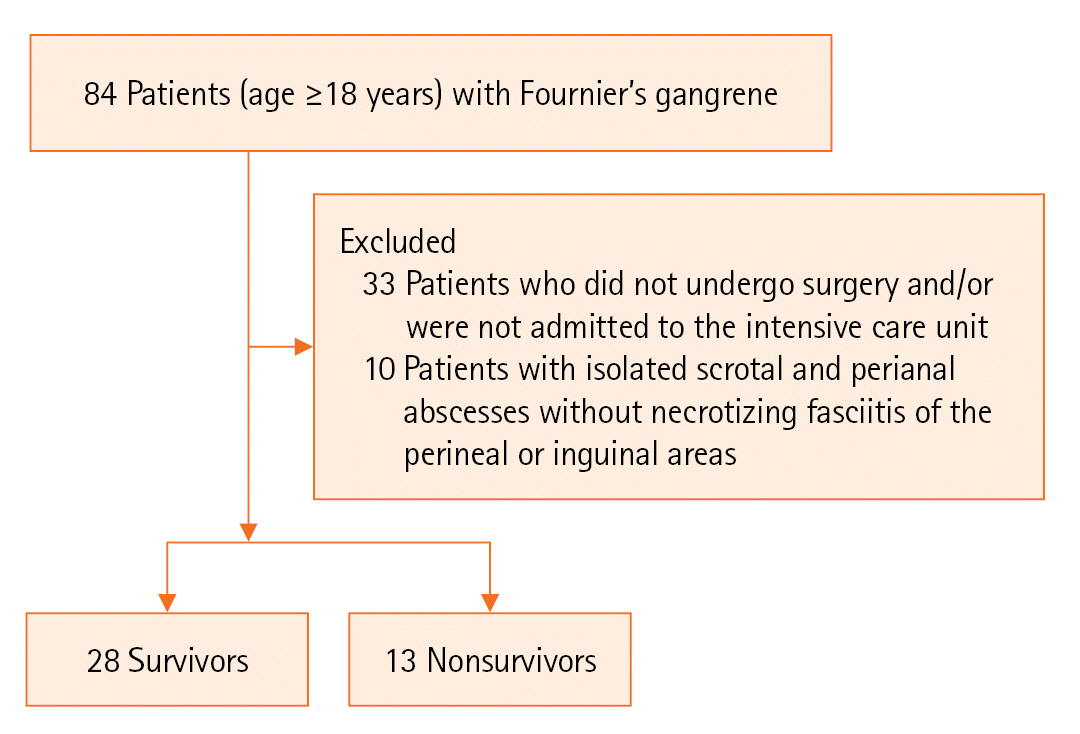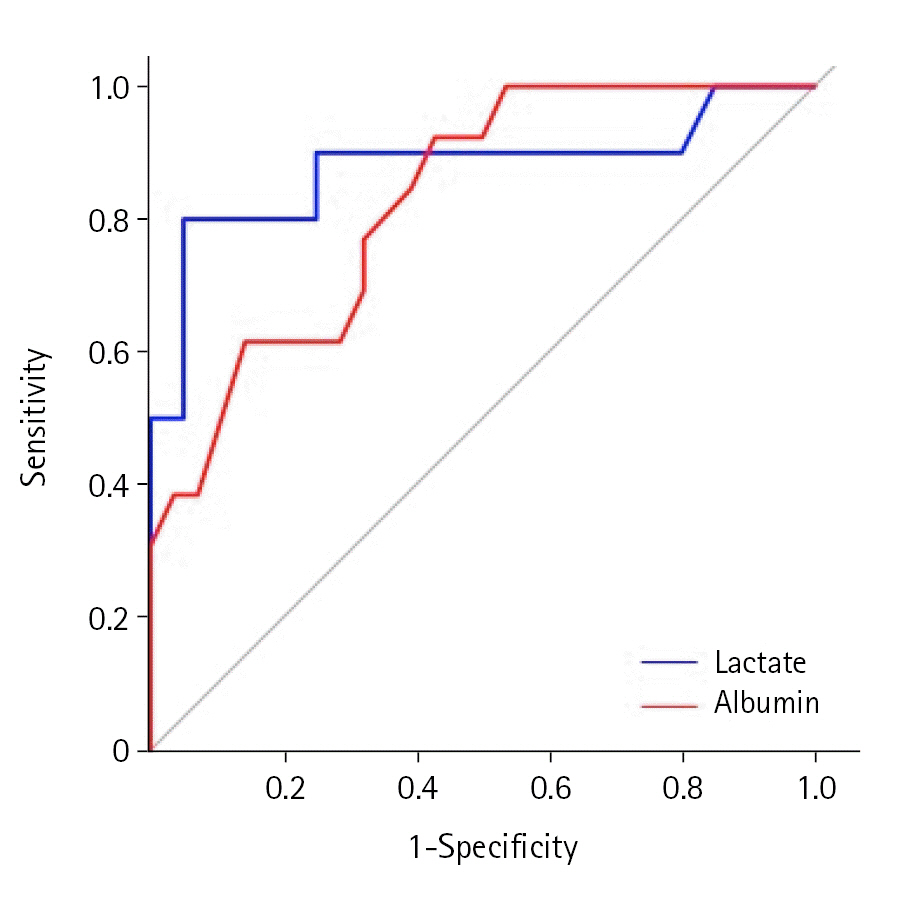Acute Crit Care.
2023 Nov;38(4):452-459. 10.4266/acc.2023.00766.
Biomarkers to predict mortality in patients with Fournier’s gangrene admitted to the intensive care unit after surgery in South Korea
- Affiliations
-
- 1Department of Surgery, Yonsei University Wonju College of Medicine, Wonju, Korea
- KMID: 2550901
- DOI: http://doi.org/10.4266/acc.2023.00766
Abstract
- Background
The use of biomarkers to predict patient outcomes may be crucial for patients admitted to the intensive care unit (ICU) following surgery because biomarkers guide clinicians in tailoring treatment plans accordingly. Therefore, we aimed to identify potential biomarkers to predict the prognosis of patients with Fournier’s gangrene (FG) admitted to the ICU after surgery.
Methods
We enrolled patients with FG admitted to our Hospital between January 2013 and December 2022. We retrospectively analyzed patient characteristics, factors related to management, scores known to be associated with the prognosis of FG, and laboratory data.
Results
The study population included 28 survivors and 13 nonsurvivors. The initial serum lactate level taken in the emergency department; white blood cell, neutrophil, and platelet counts; delta neutrophil index and international normalized ratio; albumin, glucose, HCO3, and postoperative lactate levels; and the laboratory risk indicator for necrotizing fasciitis differed between survivors and nonsurvivors. Postoperative lactate and initial albumin levels were independent predictors of mortality in patients with FG. In the receiver operating characteristic curve analysis, the postoperative lactate level was the best indicator of mortality (area under the curve, 0.877; 95% confidence interval, 0.711–1.000). The optimal cutoff postoperative lactate level for predicting mortality was 3.0 mmol/L (sensitivity, 80.0%; specificity, 95.0%).
Conclusions
Postoperative lactate and initial albumin levels could be potential predictors of mortality in patients with FG admitted to the ICU after surgery, and the optimal cutoff postoperative lactate and initial albumin levels to predict mortality were 3.0 mmol/L and 3.05 g/dl, respectively. Large-scale multicenter prospective studies are required to confirm our results.
Keyword
Figure
Reference
-
1. Carroll PR, Cattolica EV, Turzan CW, McAninch JW. Necrotizing soft-tissue infections of the perineum and genitalia. Etiology and early reconstruction. West J Med. 1986; 144:174–8.2. Orhan E, Şenen D. Using negative pressure therapy for improving skin graft taking on genital area defects following Fournier gangrene. Turk J Urol. 2017; 43:366–70.
Article3. Shin IS, Gong SC, An S, Kim K. Delta neutrophil index as a prognostic factor for mortality in patients with Fournier's gangrene. Int J Urol. 2022; 29:1287–93.
Article4. Garg G, Singh V, Sinha RJ, Sharma A, Pandey S, Aggarwal A. Outcomes of patients with Fournier's Gangrene: 12-year experience from a tertiary care referral center. Turk J Urol. 2019; 45:S111–6.
Article5. Gadler T, Huey S, Hunt K. Recognizing Fournier's gangrene in the emergency department. Adv Emerg Nurs J. 2019; 41:33–8.
Article6. Kim KM, Seong SH, Won DY, Ryu H, Kim IY. The prognostic factors and severity index in Fournier’s gangrene. J Korean Soc Coloproctol. 2010; 26:29–33.
Article7. Eray IC, Dalci K, Gumus S, Yalav O, Saritas AG, Boz A, et al. The role of C-reactive protein ratio in predicting mortality in patients with Fournier gangrene. Ann Coloproctol. 2023; 39:223–30.
Article8. Friederichs J, Hutter M, Hierholzer C, Novotny A, Friess H, Bühren V, et al. Procalcitonin ratio as a predictor of successful surgical treatment of severe necrotizing soft tissue infections. Am J Surg. 2013; 206:368–73.
Article9. Laor E, Palmer LS, Tolia BM, Reid RE, Winter HI. Outcome prediction in patients with Fournier's gangrene. J Urol. 1995; 154:89–92.
Article10. Yilmazlar T, Ozturk E, Ozguc H, Ercan I, Vuruskan H, Oktay B. Fournier's gangrene: an analysis of 80 patients and a novel scoring system. Tech Coloproctol. 2010; 14:217–23.
Article11. Wong CH, Khin LW, Heng KS, Tan KC, Low CO. The LRINEC (Laboratory Risk Indicator for Necrotizing Fasciitis) score: a tool for distinguishing necrotizing fasciitis from other soft tissue infections. Crit Care Med. 2004; 32:1535–41.
Article12. Kushimoto S, Akaishi S, Sato T, Nomura R, Fujita M, Kudo D, et al. Lactate, a useful marker for disease mortality and severity but an unreliable marker of tissue hypoxia/hypoperfusion in critically ill patients. Acute Med Surg. 2016; 3:293–7.
Article13. Li X, Yang Y, Zhang B, Lin X, Fu X, An Y, et al. Lactate metabolism in human health and disease. Signal Transduct Target Ther. 2022; 7:305.
Article14. Wiedermann CJ. Hypoalbuminemia as surrogate and culprit of infections. Int J Mol Sci. 2021; 22:4496.
Article15. Moon JJ, Kim Y, Kim DK, Joo KW, Kim YS, Han SS. Association of hypoalbuminemia with short-term and long-term mortality in patients undergoing continuous renal replacement therapy. Kidney Res Clin Pract. 2020; 39:47–53.
Article16. Tuncel A, Aydin O, Tekdogan U, Nalcacioglu V, Capar Y, Atan A. Fournier's gangrene: three years of experience with 20 patients and validity of the Fournier's Gangrene Severity Index Score. Eur Urol. 2006; 50:838–43.
Article17. Sabzi Sarvestani A, Zamiri M, Sabouri M. Prognostic factors for Fournier's gangrene: a 10-year experience in Southeastern Iran. Bull Emerg Trauma. 2013; 1:116–22.18. Üreyen O, Acar A, Gökçelli U, Atahan MK, İlhan E. Usefulness of FGSI and UFGSI scoring systems for predicting mortality in patients with Fournier's gangrene: a multicenter study. Ulus Travma Acil Cerrahi Derg. 2017; 23:389–94.19. Hong KS, Yi HJ, Lee RA, Kim KH, Chung SS. Prognostic factors and treatment outcomes for patients with Fournier's gangrene: a retrospective study. Int Wound J. 2017; 14:1352–8.
Article20. Noegroho BS, Siregar S, Mustafa A, Rivaldi MA. Validation of FGSI scores in predicting Fournier gangrene in tertiary hospital. Res Rep Urol. 2021; 13:341–6.
Article21. Nahm CH, Choi JW, Lee J. Delta neutrophil index in automated immature granulocyte counts for assessing disease severity of patients with sepsis. Ann Clin Lab Sci. 2008; 38:241–6.22. Kim JW, Park JH, Kim DJ, Choi WH, Cheong JC, Kim JY. The delta neutrophil index is a prognostic factor for postoperative mortality in patients with sepsis caused by peritonitis. PLoS One. 2017; 12:e0182325.
Article23. Kong T, Park YS, Lee HS, Kim S, Lee JW, You JS, et al. The delta neutrophil index predicts the development of in-hospital hypotension in initially stable patients with pyogenic liver abscess. Sci Rep. 2019; 9:12105.
Article



